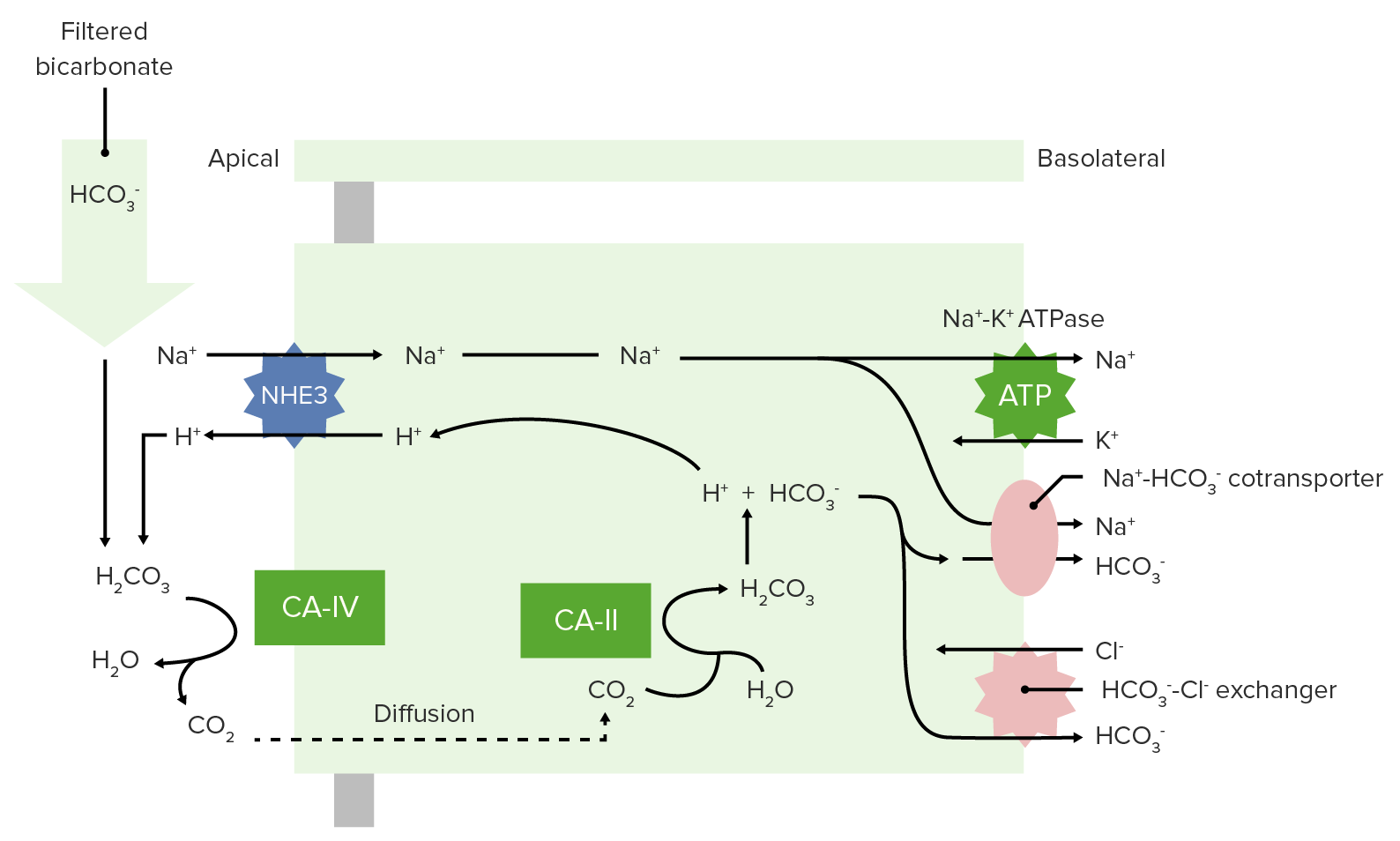Playlist
Show Playlist
Hide Playlist
Acid-Base Box
-
Slides 09 ToolsCompensation AcidBaseBalance GeneralPhysiology.pdf
-
Download Lecture Overview
00:00 Acid-Base Balance We’re going to go for some tools, some disturbances and how the body compensates for them. 00:09 Here the first tool we’re going to use is the Acid-base Box. 00:13 Acid-base boxes are a nice simple way to look at a disorder. 00:18 Now, disorders are going to be things like acidosis and alkalosis. 00:24 These are the conditions that you’ll get to have an acidosis or an alkalosis. 00:30 So, you might have a respiratory acidosis or a metabolic acidosis or a respiratory alkalosis or respiratory acidosis. 00:40 Those –osis portions are the condition that is involved. 00:45 If we want to look at blood pH, we call an –emia. 00:50 So, you could have an acidemia or an alkalemia. 00:55 For a metabolic component, we’re only really looking at bicarb levels. 01:00 We have the edges of the box at 22 millimole and 28 millimole. 01:06 Although, 24 to 25 millimole is what we would normally see. We give it a little bit of a range. 01:14 Our respiratory component, is PaCo2, which is the partial pressure of arterial carbon dioxide. 01:24 Here, we have to do something pretty crazy and we have to flip around our lefts to rights to make this work out. 01:31 We’re going to have 48 PaCO2 and 32 PaCO2. 01:39 If we want to use our first example, so let’s just go through one of these. 01:44 just to go through the naming process of which condition might be involved. 01:49 If we did an arterial blood gas measurement, and we got a pH of 7,62 that would give us a blue gnome outside the box. 02:01 A bicarb of 18 gives us a red gnome outside the box on the acidosis side. 02:09 And finally, a CO2 value of 18 gives us a blue gnome on the alkalosis side. 02:17 This is the beauty of an Acid-base box because we can name this disorder. 02:23 If they have this arterial blood gas, you could look at the Acid-base box and say ‘’Respiratory alkalosis’’. Why? Cos there are two gnomes on one side. 02:36 that’s how the naming goes, respiratory alkalosis. 02:41 We might ask what do you do with that gnome on the opposite side? He was an acidic gnome, why is he out there on the bicarb side? Well, just so happens that the body is trying to compensate for the respiratory alkalosis. 02:57 So, if we are going to name that, it would be a respiratory alkalosis with metabolic compensation. 03:03 That naming process all works with these simple acid-base boxes. 03:09 I know right now you’re going to ‘’What is he talking about?’’. 03:12 Let’s go through another example. 03:14 Let’s say we have a pH of 7,59 obtained through an arterial blood gas. 03:21 Blue gnome outside the box. 03:24 We get a bicarb value now of 24. 03:28 So, now we’re going up through a green gnome inside the box. 03:32 Why is he inside the box? Because you’re going from 25 to 22, you’re somewhere within that range. 03:42 If you’re below 22, you’ll be outside the box. 03:46 In the box, because it’s within the 22 to 25 range. 03:51 Finally, PCO2, 26 millimeters of mercury, that’s another blue gnome outside the box. 04:00 So, of course we can name this. We can name this disorder, it is a respiratory alkalosis without metabolic compensation. 04:09 Why do I know that? Two gnomes on the same side outside the box. That’s how the naming works. 04:17 Why did I know there was not a lot of metabolic compensation? Because if the body was trying to compensate, they would have put the gnome outside the box. 04:27 If the gnome is in the box, no compensation yet. 04:31 Outside the box, would have got some compensation.
About the Lecture
The lecture Acid-Base Box by Thad Wilson, PhD is from the course Acid-Base Balance.
Included Quiz Questions
What is the underlying acid-base disorder in a patient with the following blood-gas values: PaCO2 of 40mm Hg, HCO3 of 6 mmol/l, and pH of 7.1.?
- Metabolic acidosis
- Respiratory acidosis
- Respiratory alkalosis
- No acid-base imbalance
- Metabolic alkalosis
Suppose you were using an acid-base box and you observed red gnomes outside the box on the left for both pH and HCO3-, and then a blue gnome outside the box on the right. What disorder does this represent?
- Metabolic acidosis with respiratory compensation
- Metabolic acidosis without respiratory compensation
- Respiratory acidosis with metabolic compensation
- Respiratory acidosis without metabolic compensation
A child with acute asthma has a PaCO2 of 52 mmHg, a pH of 7.31, and a normal HCO3 blood gas value. Which of the following is the most likely diagnosis?
- Respiratory acidosis
- Respiratory alkalosis
- Metabolic acidosis
- Metabolic alkalosis
- Normal
After surgery, the following values were obtained from an arterial blood sample: pH 7.54, PaCO2 50 mm Hg, and HCO3 41 mmol/l. What is the underlying disorder?
- Metabolic alkalosis
- Respiratory alkalosis
- Metabolic acidosis
- Respiratory acidosis
Customer reviews
4,6 of 5 stars
| 5 Stars |
|
8 |
| 4 Stars |
|
0 |
| 3 Stars |
|
0 |
| 2 Stars |
|
0 |
| 1 Star |
|
1 |
Thank you so much, Dr Thad. You're very clever in coming up with the 'gnomes' example, which is perfect for quickly understanding Acid-base. Thanks again.
Beautifully described. Clear and concise presentation. Your all lectures are brilliant
This is completely inadequate for the questions posed. The first question gives "you observed red gnomes outside the box on the left for both pH and HCO3" and asks for the condition. Verbatim from the lecture ‘’Respiratory alkalosis’’. Why? Cos there are two gnomes on one side." Yet the answer is metabolic acidosis.
Clean and clear. Simple explanations. He knows the subject for sure.




